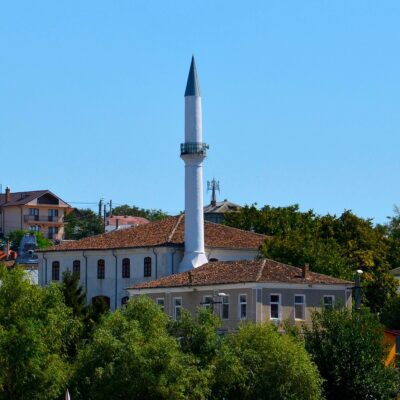The city of Tulcea has a complex history that comes to light once you approach the many monuments and museums that can be found here. A walk on the seafront is also an activity not to be missed.
A visit to Tulcea, to be complete, must include a trip to the Danube Delta. So, after exploring the city, set aside time for this experience as well. Tip: an authentic tour must end with a traditional meal.
The first documentary attestation of the city dates from 1506. During 1420-1988, the town was ruled by the Ottomans. The Russo-Turkish War (1877-1878) resulted in Tulcea becoming part of the Romanian state.
The Treaty of Berlin attests to the passage of North Dobrogea by Romania. After the two World Wars, the process of modernisation of the locality began, which currently has the status of industrial port city.
Tulcea is the residence of the homonymous county and is located in the southeastern part of Romania, in the north of Dobrogea. The city at the gates of the Danube Delta is located on seven hills and is surrounded to the northwest by the Danube and to the east by the Black Sea.
Cultural diversity is one of the peculiarities of this area where various ethnic groups live in harmony: Lipovans, Turks, Ukrainians, Tatars, Italians, Armenians, Hungarians, Greeks. Tulcea borders Ukraine to the north, the Black Sea to the east, Brăila and Galați to the west, and Constanța to the south.
Danube Delta Eco-Tourist Museum Center – contains exhibits that embody the natural heritage of the Danube Delta. The habitats specific to the biosphere reserve and the Razim-Sione lagoon complex are illustrated.
It is a major attraction for locals and tourists. Inaugurated in 2009, the center is dedicated to showcasing the natural heritage of the Danube Delta and the Razim-Sinoie Lagoon Complex. Here, visitors can explore a permanent exhibition highlighting the biological diversity of the region, as well as a public aquarium hosting a variety of fish species and marine invertebrates. The center also offers modern facilities, including a playground for children, an information technology library, and souvenirs available for purchase. It is an ideal place for recreation and education, with interactive activities and facilities accessible to people with disabilities.

It was once the headquarters of the National Bank of Romania, serving as an impressive example of interwar architecture, representing a harmonious blend of tradition and modernity. The museum’s collections, consisting of approximately 8000 pieces, reflect the cultural diversity of the area and offer a rich perspective on local traditions and customs: the specific multiculturalism of Dobrogea, crafts and occupations, folk costumes, traditional furniture elements.
Visiting hours:
Tuesday – Sunday: 09:00 AM – 05:00 PM
Ticket prices:
Children, students, seniors – 5 Lei
Adults – 10 Lei

It was built as a tribute to the Romanian soldiers who fought in the War of Independence (1877-1878). It symbolizes the union of Dobrogea with Romania and was inaugurated in 1904. From here, you can also see the ruins of the Aegyssus fortress.
Strategically located to offer a panoramic view of the city from the mouths of the Danube, it represents the main tourist attraction of the municipality. Destroyed in the First World War, it was rebuilt in 1933, abandoning the sculptural elements. On the occasion of the centenary of Romania’s state independence in 1977, the monument was restored to its original form, including the two sculptural elements, the work of architect Cristea Grosu.

Azizia Mosque – Or the Sultan Abdulaziz Mosque is the main place of worship for the Muslim community in Tulcea, located in the city center, erected in 1863. Founded by Sultan Abdulaziz, it is the largest mosque in Dobrogea. Restored in 1970, the mosque has carpets donated from Turkey and a minaret erected with the support of the Republic of Turkey. The building, listed in the Historical Monuments List of Tulcea County, consists of a room serving as a prayer hall for Muslim believers. At the entrance, believers leave their shoes on a raised step. Next to the building rises the minaret with a height of 25 meters and a diameter of 3.55 meters, built of stone, brick, and wood.

Avramide House – is an architectural emblem dating back to the 19th century. It belonged to an industrialist named Avramide, originally from Tulcea. Also known as the House of Collections, it is part of the North-Dobrogean Cultural Heritage Museum Complex under the “Gavrilă Simion” Eco-Museum Research Institute in Tulcea. Initially a luxurious residence, it later served as the headquarters of the Democratic Greek Committee and housed the “Danube Delta” Museum. Today, Avramide House hosts a modern exhibition about Tulcea’s history, the Avramide family, and heritage objects from the museum’s collections.
Visiting hours: Tuesday – Sunday: 09.00 – 17.00
Ticket price: 8 lei
Guide price: 40 lei

In the vicinity of the city, 15 km away, you can find the “Danube Delta Airport Tulcea” which has domestic flights (Bucharest, Constanta, Galati). The nearest airport for international flights (London, Istanbul) is “Mihail Kogălniceanu Constanța International Airport”, 105 km away.
Trains leave Constanța and Bucharest every day from the “Tulcea Oraș” station. To check the train schedule, access this site.
If you prefer to travel by bus / minibus, here you will find all the necessary information for this: bus stations and stops, departure and arrival times, destinations.
The optimal route by car on the route Bucharest-Tulcea is Drajna – Slobozia – Țăndărei – Giurgeni – Hârșova, then go on 22A until you reach your destination.

If you like music festivals, in Constanta you will find one to your taste, regardless of the style of music you prefer. Here you have a list with some of them, but you should know that every weekend there are events for all tastes.
Dichis’n’Blues – it is a music festival in which both national and international artists perform. At the same time, the participants in the event can enjoy a “Blues cruise” in the Danube Delta, and the little ones can participate in various workshops. The festival takes place at the end of August, usually between 31.08 – 1.09, at Casa Avramide in Tulcea.
What are you waiting for? Come and have a good time, enjoy music, nice people and magical places.